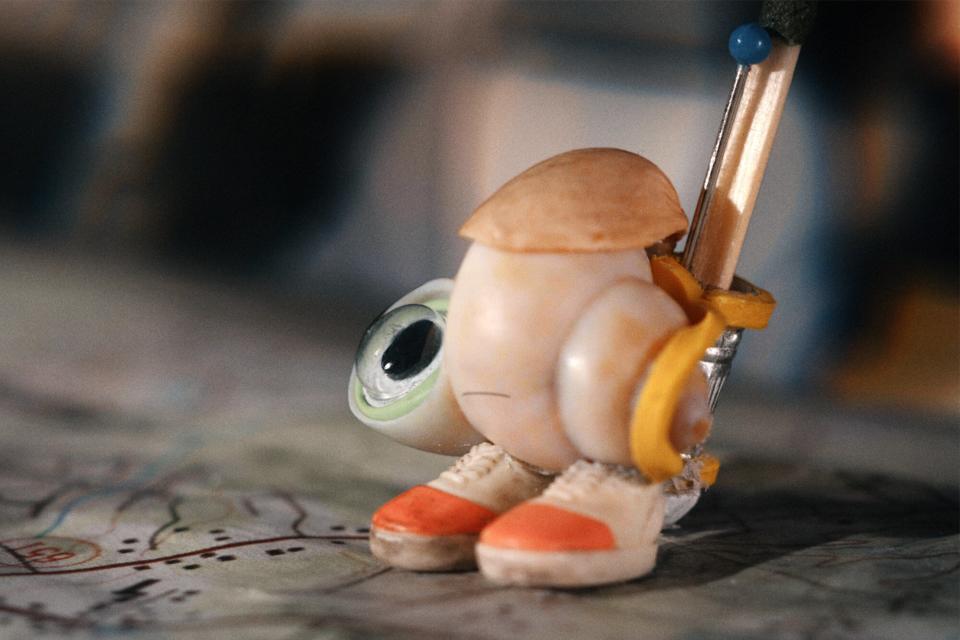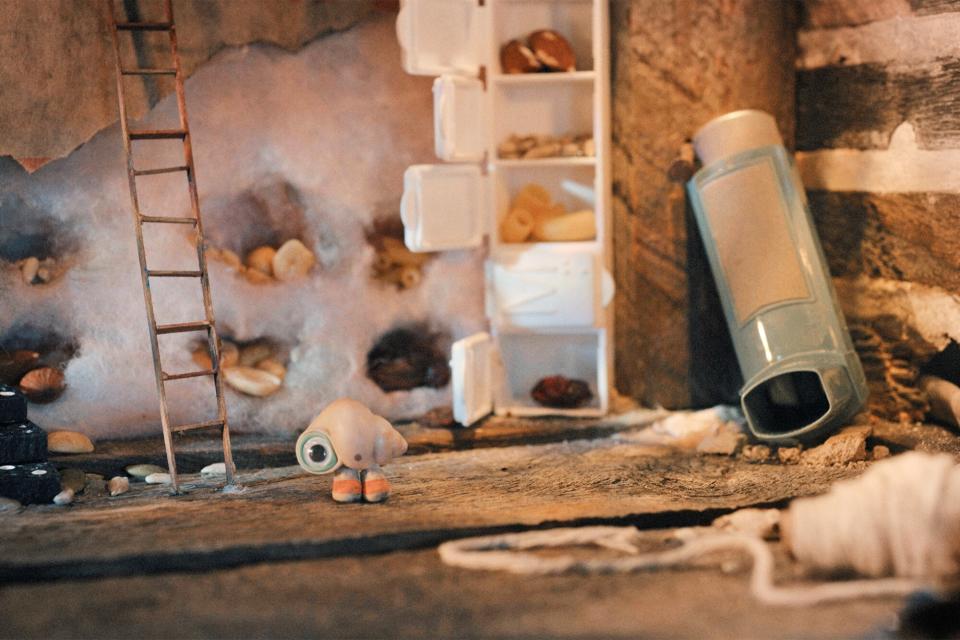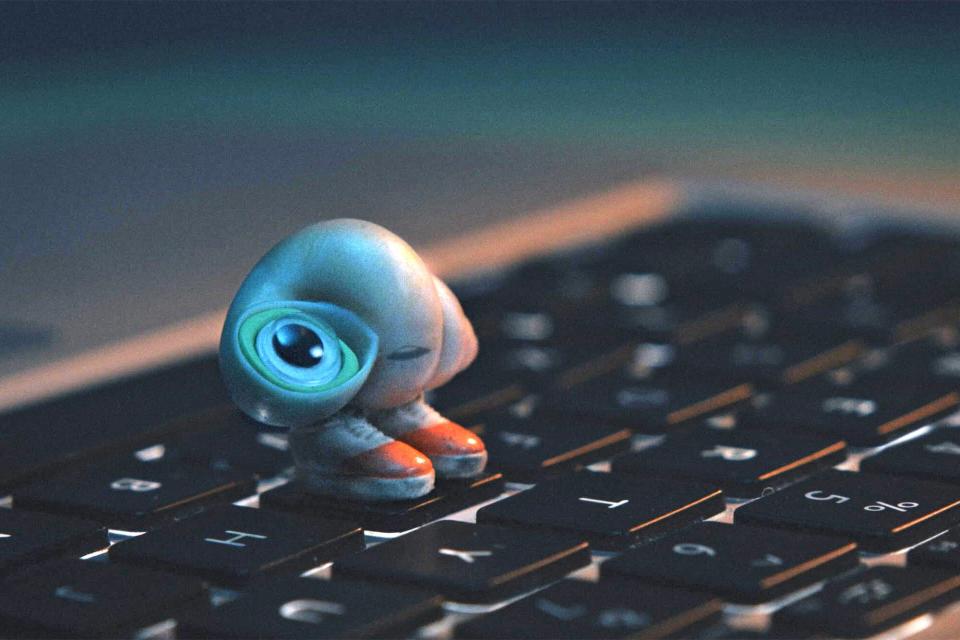Marcel the Shell team on capturing the 'staccato brokenness' of a stop-motion world

- Oops!Something went wrong.Please try again later.
When he set out to adapt his series of beloved short films about a shell named Marcel that he created with Jenny Slate, Dean Fleischer Camp was concerned about losing what made them special. Namely, a thing he calls "kind of inherently broken and skee-jawed" about stop-motion animation.
Camp enlisted animation director Kirsten Lepore — he says he met her "a million years ago" at a Sundance — to help bring the little mollusk's big world to life in the feature film Marcel the Shell With Shoes On, in theaters now, which follows the titular shell (voiced by Slate) searching for his long-lost family.
"She likes what I like about stop-motion animation, which is what's wrong with it and not what can be perfect and polished about it," Camp tells EW of Lepore, citing her rough-hewn 2010 short Bottle as an example. "A lot of our efforts on a macro level were about: How do we tell this story in a bigger, more expanded way, but not lose that charm, that sort of staccato brokenness?"
It wasn't immediately clear that their gamble to do actual stop-motion (as opposed to CGI designed to look like stop-motion) would pay dividends, he says.
"There are incredible artists in that field that have pretty much nailed the look of stop-motion, but what you can't bake into that are the mistakes," he explains. "In retrospect, I'm so glad that we went through that process because of little things. Stop-motion is a real tactile process. It's just achingly fallible in the way that humans are. It's vulnerable, it's messed up, it's broken."
Here, Lepore breaks down the specific challenges involved in bringing Marcel to the big screen.

A24
Practical world-building
A good chunk of Marcel the Shell With Shoes On takes place at his one-inch-tall level. And while the temptation might be for the filmmakers to utilize miniatures, they decided early on that it was better to use real-world items (albeit small ones) that a shell might refurbish for other purposes.
"We didn't want to use miniatures," Lepore explains. "We're basically going out, collecting all these things, and then laying them out on a table and saying, 'How can we make this into something else?' Putting on a Marcel thinking hat, what would he use to do this?'" Some examples that the art department came up with include chairs made from Champagne corks, and a little pistachio-shell cap and backpack (made from a match, a pin, and an eraser cap) that Marcel wears.
The puppet department also created new characters, Lepore recalls. "That's where all the little cereal guys got created," she says. "The little pretzel guys and the cereal guys all came from the puppet team." As for what didn't make the cut? "I think there was an empty ChapStick guy. Something with a Band-Aid. And I designed this little electrical cap guy."

A24
Shooting the shell
One of the biggest challenges presented to Lepore and her team was how to integrate stop-motion animation with real-world live-action shots. "It was very important to Dean to actually have a live-action camera moving around, roving in that documentary style, and that we would then composite Marcel into it," she says. "But it's really tricky in stop-motion, because then you're moving around the puppet. As soon as you do that, it looks too flat. It just gives away the gag."
Luckily, Lepore was able to be on set to monitor the capturing of the live-action material. "We made sure that we could translate those camera moves to motion-control rigs on the stop-motion stage," she says. "Literally, we had these massive camera rigs that are programmable, and can run through a camera move frame by frame by frame as you're shooting. It's a nerdy camera thing, but that was probably one of our biggest hurdles."

A24 Marcel next to Dean Fleischer-Camp in 'Marcel the Shell With Shoes On'
The scale and the scope
Marcel's unusually small stature, tiny even for stop-motion, was another issue. "We went back and forth a lot on: Do we go a little bit bigger?" Lepore admits. "It's like Guinness Book of World Record stuff to animate a puppet that is an inch tall. There were so many challenges inherent in that."
Ultimately, Lepore says they ended up going the small route, citing the benefits of sticking to an actual shell's size. The animators used tools that were the size of a fingernail. "We're like, 'Try not to lose them!' but how do you not drop a fingernail eventually?" she says. "That's the scale we were working with — so teeny tiny. So crazy."

A24
The eyes have it
One detail that Lepore loves about Marcel himself is the subtlety in his eye movements. "You don't really have much else to work with," the animator explains. "You've got shoes. You've got an eyeball. That's all you have. So just the subtle, tiny, little increments that we got with those eyeballs, I'm really proud of." To pull it off, the art team had to cut a bunch of googly eyes open and then glue the black pupil in a certain spot: some were glued to the side, some to the center, depending on where they needed Marcel to look.
As for getting the pupil to actually move — what's known as an eye dart — that's where things got a little tricky, but the solution was surprisingly affecting. If they just rotated one of Marcel's eyes "the tiniest little bit," it would have the desired effect. "If you did that enough times when you needed the eye dart, you would just get this little [shaking motion] because it wasn't perfectly dead center. It was such an amazing discovery. I feel like it just really helped us nail the acting."
At the end of the day, it's the sum of these shell-sized parts that Lepore is most proud of, a combination that seems to be working for audiences. "They're totally along for the emotional ride," she says. "The technical stuff doesn't take them out of it. That was really our main goal throughout the whole process."
Related content:
How Lesley Stahl wound up interviewing her tiniest subject in Marcel the Shell With Shoes On
Meet the summer's smallest but mightiest hero, Marcel the Shell
Marcel searches for his lost family in adorable Marcel the Shell With Shoes On movie trailer
Marcel is a little mollusk in a big world in first look at Marcel the Shell With Shoes On movie

